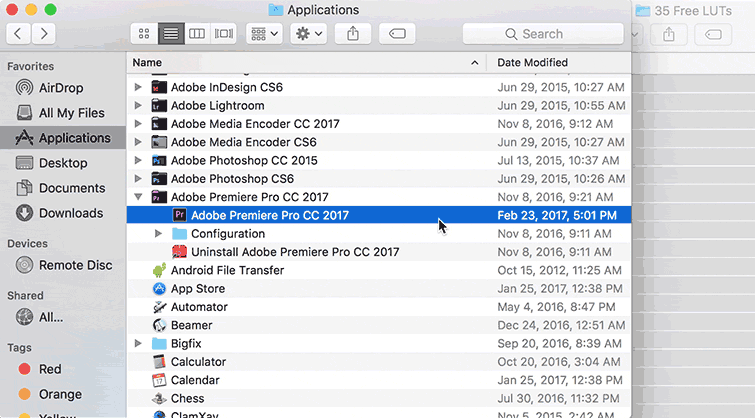


Method 3: Import LUTs in Davinci Resolve using Project Settings To avoid this issue, ensure that you only point the LUTs location to your main LUTs folder. It is important to note that if you point the LUTs location to a specific subfolder within your main LUTs folder, the LUTs will be mixed with the pre-installed LUTs, making it difficult to identify your custom LUTs. Your custom LUTs should now be visible within the LUTs tab.
#Import luts into premiere pro update
Select “Refresh” to update the LUTs list with your newly added LUTs. Return to the color page in DaVinci Resolve and right-click on the LUTs tab.Once you have navigated to your main LUTs folder, click “Select Folder” to add it to the list of LUTs locations.We recommend creating a main folder for all your LUTs and pointing the LUTs Location to this folder for easier organization. Click “Add” and navigate to the folder where you have stored your LUTs.This feature allows you to specify multiple folders for LUTs. In the General tab, you will find the “LUTs Location” section.Click on “Preferences” and then select the “General” tab.Close the LUTs folder and navigate to the top-left corner of the screen, where you will find the “DaVinci Resolve” menu.Method 2: Creating a Custom LUTs Folder (Recommended) You can choose to add your LUTs to this location, but we do not recommend this method as it might lead to disorganization.To find the location of these LUTs, right-click on any LUT and select “Open File Location.” This will display the folder where the LUTs are installed.Click on the LUTs tab to reveal a list of pre-installed LUTs, which are organized into different folders.You will find the LUTs tab at the top left of the screen. First, navigate to the color page in DaVinci Resolve.Method 1: Adding LUTs to the Default Folder There are three methods to add LUTs to DaVinci Resolve, and we will cover them in detail. LUTs are used for color grading and can drastically improve the look and feel of your footage. In this blog post, we will guide you through the process of importing LUTs (Look-Up Tables) into DaVinci Resolve for your projects.
#Import luts into premiere pro how to
Enjoy! How to import LUTs: DaVinci Resolve In the end, we also share a tip to help you adjust the intensity of a LUT. In this one we help you with, Importing and Exporting LUTs in Davinci Resolve. Hey wassup guys, welcome back to, This article is going to be super interesting for sure. So do not take shortcuts and believe us, once you get the hold of it you will find the process interesting rather than intimidating.How to Adjust LUTs Intensity in Davinci Resolve Well because if this knowledge is not absorbed properly, you will mess up along the way losing valuable time, energy and money. Usage of LUTs is entirely a creative choice, you may settle with one LUT for the entirety of your film/video or you may choose to add different LUTs for different scenes. That may require you to use one or more LUTs, that is so because any LUT can give predictable output for only a number of footages on your timeline, not all of them, hence adjustments are necessary to maintain consistency in the color scheme of the film. To answer this first be clear about the color scheme you want your whole video/film to follow. Why choose creative LUTs?ĭon’t we all want the pro, sophisticated, distinctive, vividly color-graded look for our videos? Creative LUTs help saves a lot of our time to achieve that. Since ‘color’ is used in both the terms it can be ambiguous to remember the real distinction in the nature of both the terms and may lead to filmmakers thinking the border between the two is so thin that it can be easily crossed but we must know and carefully deal with the processes in a particular order. Both the processes must never be confused with each other, neither mixed nor skipped. Color grading is not meant to do color correction work and color correction is not meant to do color grading. This basically means adjusting exposure, highlights, shadows, mid-tones, white-balance, contrast, and saturation so that the flat-looking footage falls easy on the eyes, begin to look vivid, and lays the foundation for the color-grading with creative LUT, to be done in the next step.Ĭreative LUTs are calibrated only to be added and worked upon, on footages that have been color corrected. Since we shoot with different cameras under different conditions and that each scene happens to be a bit different from preceding and succeeding scenes, we need to correct how lights are received throughout the whole video/film. This practice allows your colorist to have maximum control in playing with colors during the whole color grading process and that lets your film get as close as possible to the look you had originally envisioned.

It is advised to manually choose the neutral or flat profile within your camera to shoot with because these profiles allow for high-dynamic-range for your camera to record details in.


 0 kommentar(er)
0 kommentar(er)
